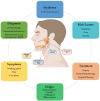MicroRNAs' Crucial Role in Salivary Gland Cancers' Onset and Prognosis
- PMID: 36358723
- PMCID: PMC9657964
- DOI: 10.3390/cancers14215304
MicroRNAs' Crucial Role in Salivary Gland Cancers' Onset and Prognosis
Abstract
Salivary gland cancer (SGC) is an uncommon and heterogeneous disease that accounts for around 8.5% of all head and neck cancers. MicroRNAs (miRNAs) consist of a class of highly conserved, short, single-stranded segments (18-25 nucleotides) of noncoding RNA that represent key gene-transcription regulators in physiological and pathological human conditions. However, their role in SGC development and progression is not completely clear. This review aims to compile and summarize the recent findings on the topic, focusing on the prognostic and diagnostic value of the major modulated and validated microRNAs in SGC. Their differential expression could possibly aid the clinician in delivering an early diagnosis, therapeutic strategy and precision medicine.
Keywords: biomarkers; diagnosis; microRNAs; prognosis; salivary gland cancer.
Conflict of interest statement
The authors declare no conflict of interest.
Figures
Similar articles
-
miRNAs orchestration of salivary gland cancer- Particular emphasis on diagnosis, progression, and drug resistance.Pathol Res Pract. 2023 Aug;248:154590. doi: 10.1016/j.prp.2023.154590. Epub 2023 Jun 7. Pathol Res Pract. 2023. PMID: 37295259 Review.
-
Overexpression of sphingosine kinase 1 is associated with salivary gland carcinoma progression and might be a novel predictive marker for adjuvant therapy.BMC Cancer. 2010 Sep 16;10:495. doi: 10.1186/1471-2407-10-495. BMC Cancer. 2010. PMID: 20846391 Free PMC article.
-
The potential role of miRNAs in the pathogenesis of salivary gland cancer - A Focus on signaling pathways interplay.Pathol Res Pract. 2023 Jul;247:154584. doi: 10.1016/j.prp.2023.154584. Epub 2023 May 30. Pathol Res Pract. 2023. PMID: 37267724 Review.
-
Astrocyte elevated gene-1 (AEG-1) is a marker for aggressive salivary gland carcinoma.J Transl Med. 2011 Dec 1;9:205. doi: 10.1186/1479-5876-9-205. J Transl Med. 2011. PMID: 22133054 Free PMC article.
-
Circulating MicroRNAs as Biomarkers in Biliary Tract Cancers.Int J Mol Sci. 2016 May 23;17(5):791. doi: 10.3390/ijms17050791. Int J Mol Sci. 2016. PMID: 27223281 Free PMC article. Review.
Cited by
-
Current Developments in Diagnosis of Salivary Gland Tumors: From Structure to Artificial Intelligence.Life (Basel). 2024 Jun 5;14(6):727. doi: 10.3390/life14060727. Life (Basel). 2024. PMID: 38929710 Free PMC article. Review.
References
Publication types
LinkOut - more resources
Full Text Sources




